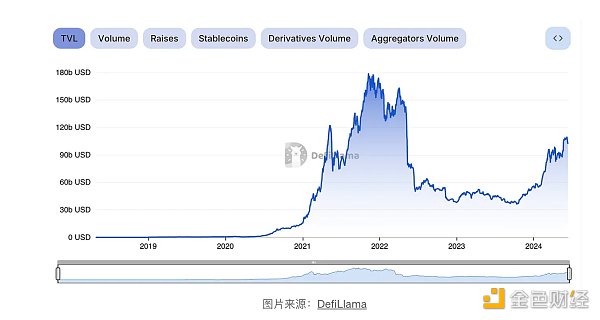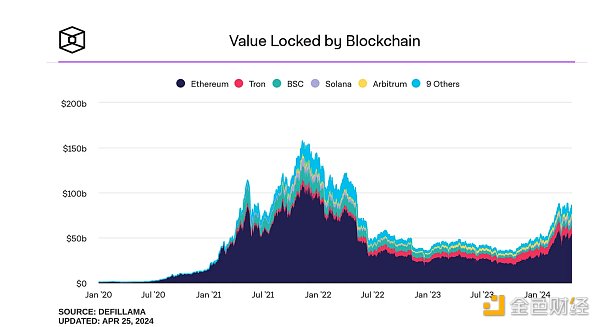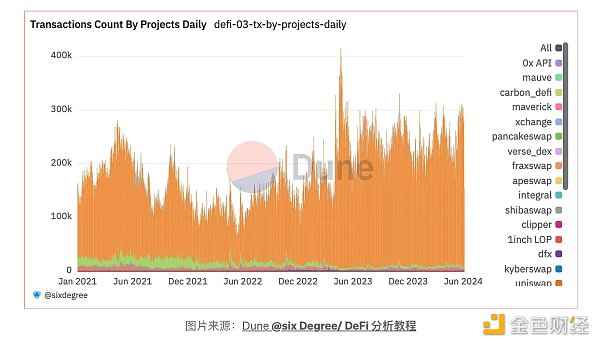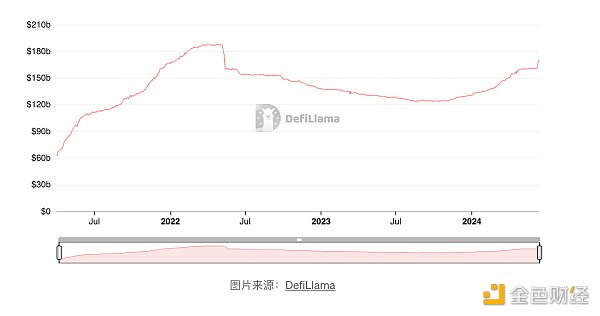Author: Filippo Pozzi Source: medium Translation: Shan Ouba, Golden Finance
Goal of this article: Get a complete and detailed picture of the "health" of DeFi within the main blockchain ecosystems
Methodology: Analyze the data as usual. In particular we will see:
Total Locked Value (TVL)
The first metric we analyze is the Total Locked Value (TVL), which is one of the most important within the space.
Before continuing, it is important to reflect on why analyzing this metric is crucial. TVL represents the total value of cryptocurrencies locked or frozen in DeFi protocols through smart contracts for various purposes such as cryptocurrency trading, lending, liquidity mining, staking and other decentralized financial activities.
High TVL indicates that the services provided by DeFi are widely used and people have a strong interest in operating in the DeFi ecosystem; conversely, low TVL indicates a low interest in this decentralized financial solution.

It can be clearly seen from the above figure that the overall TVL within all blockchains showed exponential growth during 2021, and then fell back, from a peak of US$180 billion to a low of about US$30 billion. However, over the past year, we have seen a new period of growth, with TVL currently around $100 billion.
In line with the general trend in cryptocurrencies, TVL experienced a period of strong distrust between mid-2022 and the end of 2023. This is partly attributed to the failure of the famous TerraLuna protocol and the subsequent bear market. Nevertheless, the chart presents a rather positive outlook for the next year, showing a significant recent growth in TVL. This growth is attributed to the new trust users have in DeFi products.
Total Value Locked by Blockchain
Continuing with the analysis of TVL, let’s now focus on where these stores of value are located. Until a few years ago, almost 100% of TVL was on Ethereum. However, over time, the situation has changed. While Ethereum is still the number one blockchain, an ecosystem of alternative blockchains has played a significant role in the industry.
A small clarification is that it is incorrect to call all existing blockchains “alternative blockchains” (relative to Ethereum). In fact, Ethereum’s second-layer networks, despite being autonomous blockchains, share most of their technology with Ethereum. Therefore, these are considered extensions of Ethereum, not alternatives.

As mentioned before, Ethereum remains the most important player in DeFi, currently holding over 60% of the total TVL. It is followed by Tron with over 8%, being the reference blockchain for the creation of the most used stablecoin USDT. Next is BSC with 5.19%, one of the oldest blockchains in the space, which has slightly lost importance in DeFi, with more advanced networks like Solana and Arbitrum holding 4.37% and 2.95% respectively.
After the Dencun update, here is a link to one of my articles explaining the importance of this update in the Ethereum ecosystem and its layer 2. As far as I would expect to see (and we are in the realm of speculation) is a gradual increase in activity on the main layer 2, due to the unparalleled ease and speed of operations compared to the Ethereum blockchain.
Number of Transactions
Although I prioritized the analysis of TVL in this article, and I believe this metric is extremely important, I do not believe it is the most indicative of the health of the ecosystem. In fact, TVL is directly affected by the value of capital locked in smart contracts.
Suppose that during a bear market (similar to what we saw between 2022 and 2023), no users withdraw capital from DeFi protocols. However, the depreciation of the underlying assets would still lead to a drop in TVL, giving the false impression that capital is flowing out of the ecosystem.
That is why we now turn to analyzing the number of transactions taking place in DeFi protocols, as we believe it will tell us a different story than the TVL chart. Looking at this chart, we can notice a significant difference from the one highlighted in the TVL analysis. Although there has been a decline in trading volume after the summer of 2021, this decline is not comparable to the decline recorded by TVL. Furthermore, it is important to note that after the number of transactions peaked in the summer of 2021 and declined in 2022, it has already significantly exceeded the 2021 peak in April 2023 and continues to record numbers above the 2021 peak, thus indicating a growing interest in the DeFi space and increasing activity in these protocols.
Most Used Protocols
Now let’s analyze the previous chart from another angle, focusing on the source of transactions to identify the most relevant protocols in DeFi.
 From my perspective, the results revealed by this chart are quite surprising. Before starting this research, I thought Uniswap (indicated by the orange candles) was one of the most relevant protocols in the space. However, the results left me speechless, indicating that Uniswap represents the vast majority of DeFi transactions so far in 2021, followed by Sushiswap and Curve.
From my perspective, the results revealed by this chart are quite surprising. Before starting this research, I thought Uniswap (indicated by the orange candles) was one of the most relevant protocols in the space. However, the results left me speechless, indicating that Uniswap represents the vast majority of DeFi transactions so far in 2021, followed by Sushiswap and Curve.
While being surprised by this chart, it is important to note that the chart represents the number of transactions, not the volume/USD transferred by the protocol.
Stablecoin Market Cap
The last metric we analyzed concerns the number of stablecoins present in DeFi.
But why is it important to consider the number of stablecoins in the ecosystem? The reason is simple, stablecoins = liquidity, and liquidity = potential future investment. In effect, stablecoins represent the available liquidity in the space, indicating the investing power of holders. Increased liquidity leads to new investments.
 As we can see, this chart is consistent with what is observed in other charts, with a decrease between 2022 and 2023. However, this decrease is minimal and has seen a subsequent recovery in 2024, with a small increase in recent weeks. This brings us to levels close to the historical high of $190 billion recorded in the summer of 2022.
As we can see, this chart is consistent with what is observed in other charts, with a decrease between 2022 and 2023. However, this decrease is minimal and has seen a subsequent recovery in 2024, with a small increase in recent weeks. This brings us to levels close to the historical high of $190 billion recorded in the summer of 2022.
 JinseFinance
JinseFinance
 JinseFinance
JinseFinance JinseFinance
JinseFinance JinseFinance
JinseFinance Kikyo
Kikyo Clement
Clement Davin
Davin Bitcoinist
Bitcoinist Bitcoinist
Bitcoinist Bitcoinist
Bitcoinist Bitcoinist
Bitcoinist